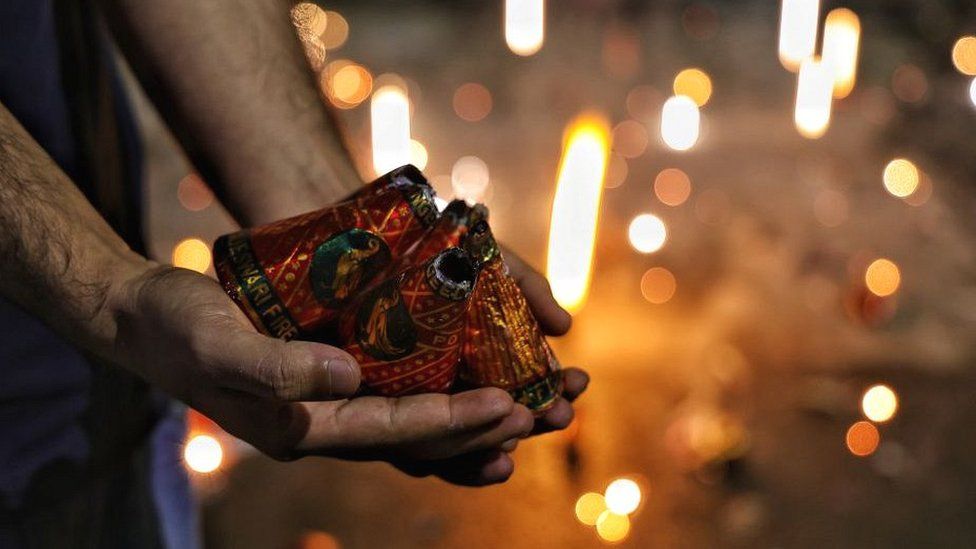Delhi air: How much pollution does Diwali cause?
- Published

India's capital Delhi has witnessed "very poor" air quality after Diwali celebrations this week, but the pollution wasn't as bad as feared.
On the day after the Diwali festival, although it was still in the "very poor" category, it was the best it has been in the last four years.
Air pollution in Delhi has been blamed on a number of factors:
- the burning of farm stubble in neighbouring states
- industrial emissions
- traffic fumes
- seasonal weather
- fireworks used during the Diwali festival
But how much do each of these contribute?
What's happened to air pollution in Delhi?
On 16 October, air quality began deteriorating as farm fires started up after a spell of rain earlier in the month that had dampened down pollution levels, and prevented farmers from burning off stubble.
Farmers in northern India usually do this every year to prepare the ground for the next round of crops.
Experts say wind speed and direction and generally favourable weather conditions are the main reasons behind the air quality not reaching the "severe" category, despite fireworks over Diwali and farmers burning stubble.
Pollution levels would usually go up as the temperature drops and wind speeds fall around Diwali season.
This year, however, the festival was celebrated several weeks earlier than usual - in October rather than early November - so the weather was not as cold as it would be normally.
How do Diwali fireworks affect air quality?
A 2018 study that attempted to answer this question says there is a "small but statistically significant" effect from Diwali fireworks.
The study focused on five locations across Delhi, and looked at data gathered between 2013 and 2016.
In two out of the four years, crop burning did not coincide directly with Diwali celebrations, making it easier to isolate the effect of fireworks.
Factoring the weather conditions into their calculations, they found increases in concentrations of PM2.5 - one of the most harmful particles to human health - of almost 40% by the second day of the festival.
This then falls back to existing background levels soon after the end of Diwali.
A report by Centre for Science and Environment, an NGO based in Delhi, showed that the concentration of PM2.5 particles rose during Diwali in each of the last four years up to 2021.
It should also be pointed out that not all fireworks produce a lot of PM2.5 particles, although the bigger ones tend to have larger concentrations.
But fireworks contain other toxic substances, and research done in the Indian city of Jamshedpur found significantly increased levels of the following substances during the Diwali period:
- PM10 particles
- sulphur dioxide
- nitrogen dioxide
- ozone
- iron
- lead
- manganese
- copper
- beryllium
- nickel
The government's own Central Pollution Control Board lists 15 substances in fireworks which it says are "hazardous and toxic".
The Indian authorities in several states have banned the sale and use of fireworks during Diwali celebrations, but enforcement of the ban has been weak.
It needs to be added that some of these toxic substances can also be produced by vehicle emissions, and vehicle traffic does increase during Diwali when people go out to buy gifts and visit family and friends.
What are the other factors causing pollution?
The impact of the seasonal burning of farm stubble varies on a daily basis, going by government data. And although the practice was banned in 2015, it still continues.
Official figures show that in November 2021, a week after Diwali, farm fires contributed 48% of PM 2.5 levels - the harmful small particles which can be inhaled.
A week later, only 10% of PM2.5 pollutants came from farm fires.
In the first two weeks of November last year, the states of Haryana and Punjab (north of Delhi) recorded 57,000 farm fires, the highest number since 2012.
This year, the number of farm fires across north India has so far been fewer than last year.
As a result, in the month of October, the amount that stubble burning contributed to Delhi's PM 2.5 levels was less than 5%.
However, closer to Diwali, the numbers of fires have begun to increase, according to India's official air quality warning system.
In states like Punjab and Haryana, farm fires increased significantly over the weekend ahead of Diwali, going by Nasa's Fire Information for Resource Management System, which uses satellite data to identify fire hotspots.
They are expected to increase further in the coming weeks.
This piece was first published in November 2018 and has been updated to reflect recent studies and pollution data.
Related Topics
- Published8 November 2018
- Published5 November 2018
- Published3 November 2018